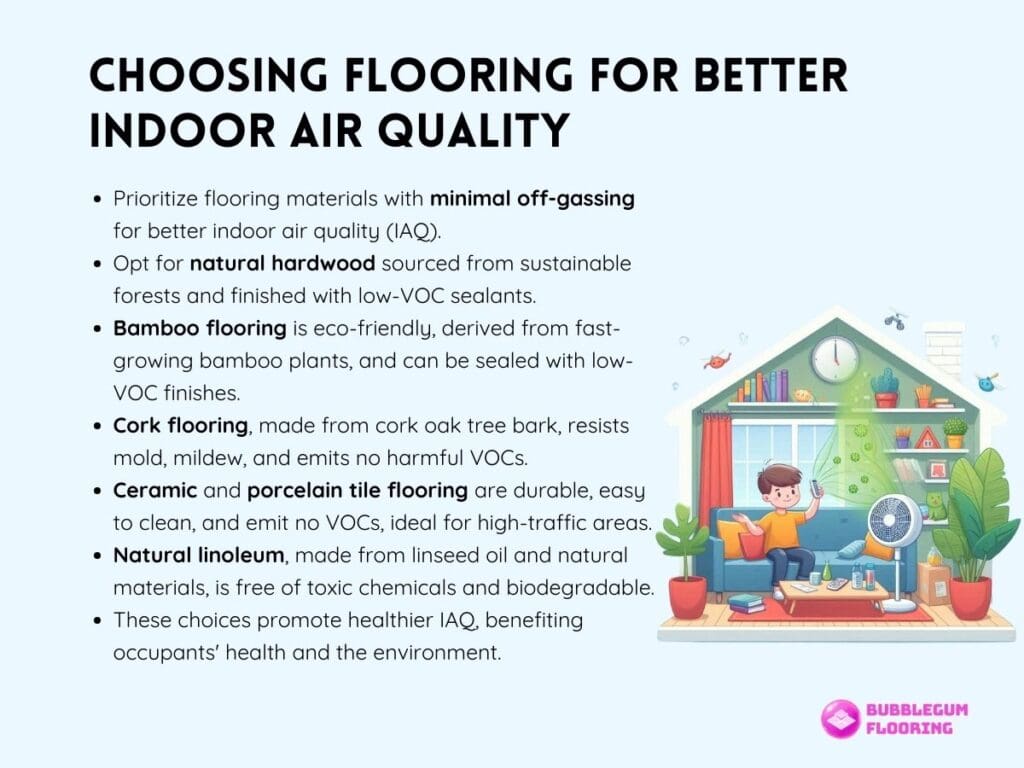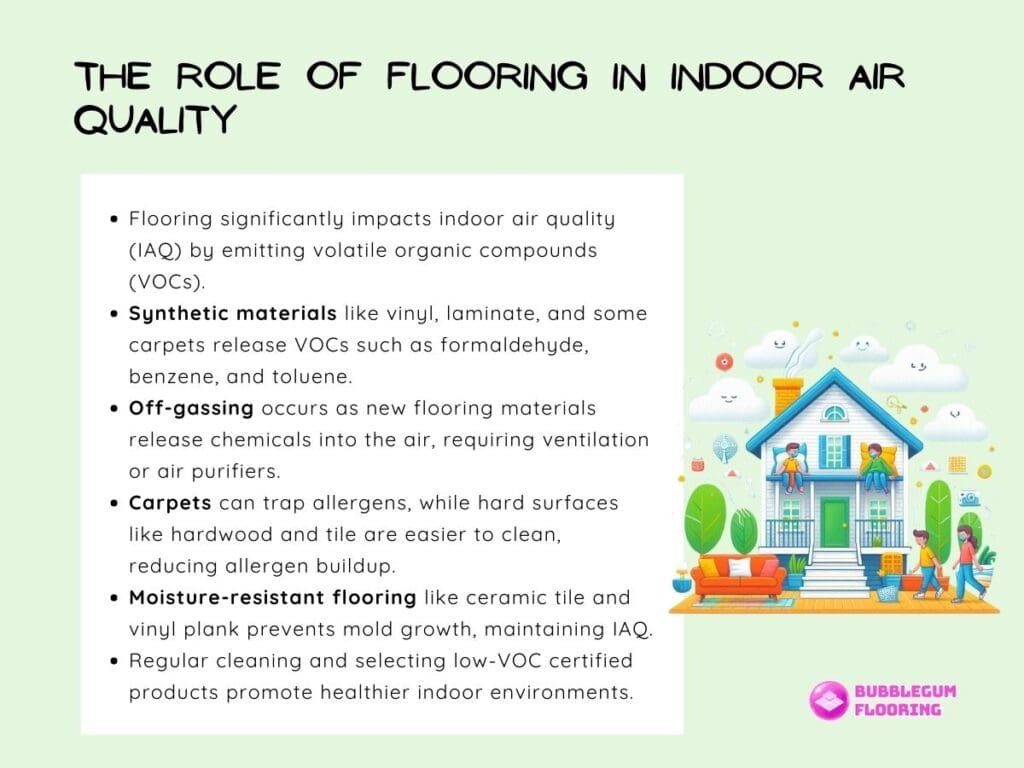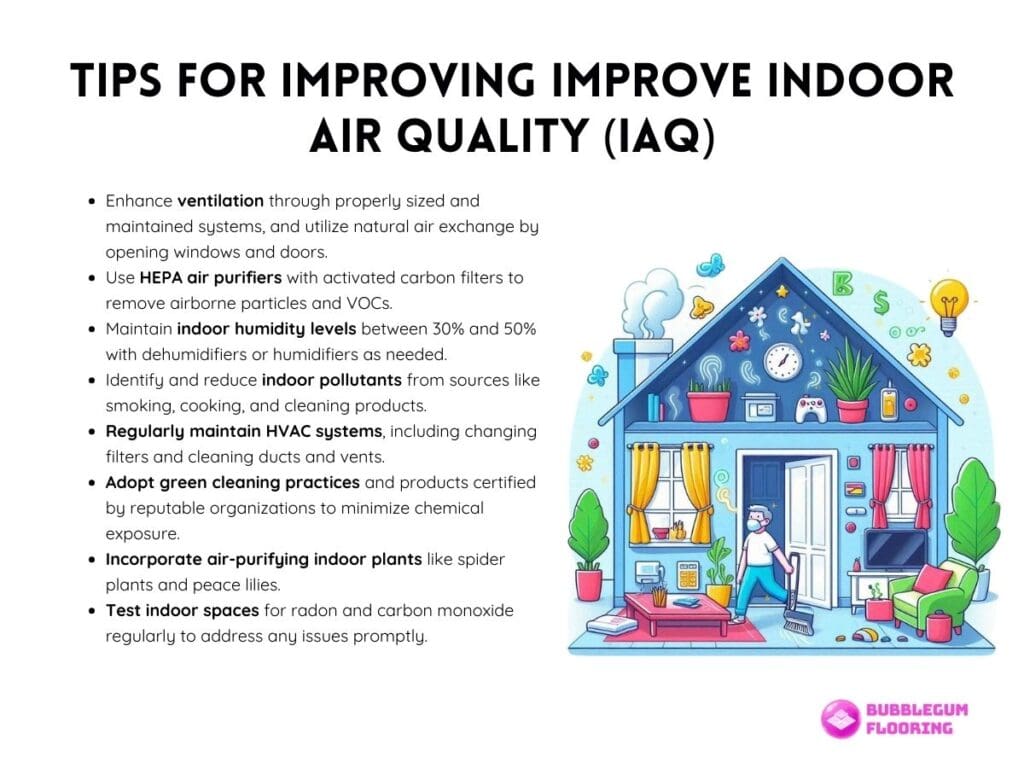The influence of flooring choices on indoor air quality (IAQ) is often underestimated, yet it holds significant importance in creating healthier indoor environments. This article ways of enhancing indoor air quality with the right flooring choices. By understanding the characteristics of different flooring materials and their implications for IAQ, individuals can make informed decisions to prioritize health and well-being.
From reducing allergens to minimizing volatile organic compound (VOC) emissions and promoting sustainability, the selection of appropriate flooring plays a crucial role in fostering healthier indoor spaces. Through this exploration, readers will gain insights into the significance of flooring choices in IAQ management and discover strategies for making optimal selections to improve indoor air quality.
Choosing Flooring for Better Indoor Air Quality
When selecting flooring materials, it is essential to prioritize options that minimize off-gassing and contribute to healthier indoor air. Here are some flooring choices that can enhance IAQ:

- Hardwood Flooring
Natural hardwood flooring, when sourced from sustainable forests and finished with low-VOC sealants, can be an excellent choice for promoting better IAQ. Hardwood floors are easy to clean and do not trap allergens like carpets do, making them ideal for individuals with respiratory sensitivities.
- Bamboo Flooring
Bamboo flooring is an eco-friendly alternative to traditional hardwood flooring. It is derived from fast-growing bamboo plants, making it a renewable resource. Like hardwood, bamboo flooring can be finished with low-VOC sealants, reducing its impact on indoor air quality.
- Cork Flooring
Cork flooring is made from the bark of cork oak trees and is another sustainable option for indoor flooring. Cork is naturally resistant to mold and mildew, making it a suitable choice for areas prone to moisture. Additionally, cork flooring does not emit harmful VOCs, contributing to healthier indoor air.
- Tile Flooring
Ceramic and porcelain tile flooring are durable, easy to clean, and do not emit VOCs. These qualities make them an excellent choice for promoting better IAQ, particularly in kitchens, bathrooms, and other high-traffic areas.
- Natural Linoleum
Linoleum is made from natural materials such as linseed oil, wood flour, cork dust, and natural pigments. Unlike vinyl flooring, which can emit harmful phthalates, linoleum is free of toxic chemicals and biodegradable, making it a more environmentally friendly option.
By choosing the right flooring materials, homeowners can minimize indoor air pollutants and promote better IAQ. Options such as hardwood, bamboo, cork, tile, and natural linoleum offer sustainable and low-emission alternatives to traditional flooring materials. Investing in these healthier flooring choices not only benefits the occupants’ health but also contributes to a more sustainable and environmentally conscious home.
The Role of Flooring in Indoor Air Quality
The role of flooring in indoor air quality (IAQ) is often underestimated but can have a significant impact on the overall health and well-being of building occupants. Flooring materials can serve as both a source of indoor air pollutants and a surface that either traps or repels allergens and contaminants. Understanding the relationship between flooring choices and IAQ is crucial for creating a healthy indoor environment.
Here are several key factors to consider:

- Emission of Volatile Organic Compounds (VOCs)
Many flooring materials, especially those made from synthetic compounds such as vinyl, laminate, and certain types of carpeting, can emit volatile organic compounds (VOCs) into the indoor air. VOCs are chemicals that evaporate at room temperature and can have adverse health effects when inhaled in high concentrations. Common VOCs found in flooring materials include formaldehyde, benzene, and toluene, which are known to cause respiratory irritation, headaches, and other health issues. Minimizing exposure to VOCs is essential for maintaining good IAQ.
- Off-Gassing
Off-gassing refers to the release of VOCs and other chemicals from flooring materials into the air over time. New flooring products, especially those that have been recently installed or treated with certain finishes or adhesives, are more likely to off-gas. The rate of off-gassing can vary depending on factors such as the type of flooring, environmental conditions, and ventilation levels. High levels of off-gassing can contribute to poor IAQ and may require measures such as increased ventilation or the use of air purifiers to mitigate.
- Allergen Trapping and Cleanability
Certain types of flooring, such as carpets and rugs, have a greater tendency to trap dust, dirt, pet dander, and other allergens within their fibers. While regular vacuuming and cleaning can help reduce allergen buildup, these materials may still contribute to poor IAQ, especially in households with allergy sufferers or individuals with respiratory sensitivities. Hard surfaces such as hardwood, tile, and laminate flooring are generally easier to clean and less likely to harbor allergens, making them preferable choices for promoting better IAQ.
- Moisture Resistance and Mold Growth
Moisture can accumulate within flooring materials, especially in areas prone to spills, leaks, or high humidity levels. Moisture infiltration can lead to mold and mildew growth, which not only poses health risks but also contributes to poor IAQ. Choosing flooring materials that are resistant to moisture and mold, such as ceramic tile, vinyl plank, or engineered hardwood, can help prevent these issues and maintain a healthier indoor environment.
- Maintenance and Product Selection
Proper maintenance of flooring is essential for preserving IAQ. Regular cleaning, including vacuuming, mopping, and spot treatment, can help remove surface contaminants and allergens. Additionally, selecting flooring products that have been certified for low VOC emissions by reputable organizations such as GREENGUARD or FloorScore can help ensure that indoor air quality is not compromised by harmful chemicals.
Choosing flooring materials that minimize off-gassing, allergen accumulation, and mold growth is key to creating a healthier indoor environment for occupants. By considering these factors and selecting appropriate flooring options, building owners and homeowners can contribute to improved IAQ and overall well-being.
Additional Tips for Improving IAQ
In addition to choosing the right flooring materials, there are several other strategies that can help improve indoor air quality (IAQ) in residential, commercial, and institutional settings. Here are some additional tips for enhancing IAQ:

Enhance Ventilation
Proper ventilation is crucial for maintaining good IAQ by diluting indoor pollutants and circulating fresh air. Ensure ventilation systems are properly sized, maintained, and operated, and consider opening windows and doors for natural air exchange.
Use Air Purifiers
HEPA air purifiers can effectively remove airborne particles, including dust, pollen, pet dander, and mold spores, improving IAQ. Choose appropriately sized models with features like activated carbon filters to capture odors and VOCs.
Control Humidity
Maintain indoor humidity levels between 30% and 50% to prevent mold and mildew growth and enhance comfort. Use dehumidifiers in humid areas and humidifiers in dry environments during winter.
Minimize Indoor Pollutants
Identify and reduce sources of indoor pollutants such as smoking, cooking emissions, and cleaning products. Opt for environmentally friendly cleaning products with low VOC emissions and avoid smoking indoors.
Maintain HVAC Systems
Regular maintenance of HVAC systems is vital for efficient operation and minimizing indoor pollutants. Change air filters regularly, clean ducts and vents, and schedule professional inspections and cleanings as needed.
Green Cleaning Practices
Use eco-friendly cleaning practices and products certified by reputable organizations like the EPA or Green Seal to minimize exposure to harsh chemicals and VOCs. Consider natural alternatives like vinegar and baking soda.
Indoor Plants
Incorporate low-maintenance, air-purifying plants like spider plants and peace lilies to improve IAQ by absorbing carbon dioxide and removing certain indoor pollutants.
Test for Radon and CO
Regularly test indoor spaces for radon and carbon monoxide using home testing kits or professional services to address any issues promptly.
By implementing these additional tips for improving IAQ in conjunction with selecting the right flooring materials, building occupants can create healthier indoor environments that promote well-being, comfort, and productivity. Regular monitoring and maintenance are key to ensuring continued IAQ improvement over time.
Considering Specific Needs
When choosing flooring materials for indoor spaces, it’s crucial to address specific needs to ensure optimal indoor air quality (IAQ) and occupant satisfaction. Tailoring flooring choices to accommodate concerns such as allergies, moisture resistance, sustainability, ease of maintenance, and acoustic performance can lead to healthier and more comfortable indoor environments.
Here are key considerations for selecting flooring materials to meet specific needs:
Allergies and Respiratory Sensitivities
Opt for hard surfaces like hardwood or laminate to minimize allergen trapping and VOC emissions, promoting better IAQ and respiratory health.
Moisture Resistance
Choose materials like ceramic tile or vinyl plank for moisture-prone areas to prevent mold and mildew growth, ensuring a healthier indoor environment.
Sustainability
Select flooring made from renewable resources such as bamboo or cork, or certified by reputable organizations for environmental performance, supporting eco-friendly building practices.
Ease of Maintenance
Prioritize options like porcelain tile or luxury vinyl plank for high-traffic areas, simplifying cleaning tasks and prolonging the flooring’s lifespan for long-term IAQ benefits.
Acoustic Performance
Opt for carpeting, cork, or rubber flooring in noise-sensitive spaces to absorb sound and reduce noise transmission, creating quieter and more comfortable indoor environments.
Considering specific needs when selecting flooring materials allows for the creation of indoor spaces that promote health, well-being, and satisfaction.
By carefully considering factors such as allergies, moisture resistance, sustainability, ease of maintenance, and acoustic performance when selecting flooring materials, indoor environments can be optimized for healthier, more comfortable living.
Key Takeaways
The article emphasizes the critical role of flooring choices in indoor air quality (IAQ) and occupant health. It underscores the importance of making informed decisions to create healthier indoor environments by tailoring flooring selections to specific needs such as allergies, moisture resistance, sustainability, maintenance, and acoustic performance.
Highlighting the benefits of various flooring materials, including their impact on allergen trapping, VOC emissions, moisture resistance, and sustainability, the article provides insights into how selecting the right flooring options can enhance IAQ and occupant satisfaction.
By considering specific needs during flooring selection, individuals can prioritize health, well-being, sustainability, and occupant satisfaction in indoor spaces.


